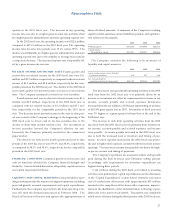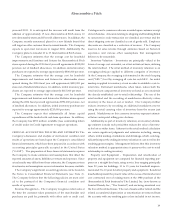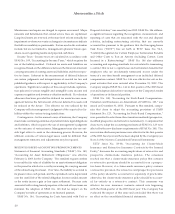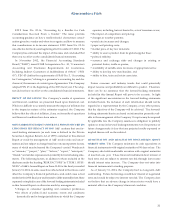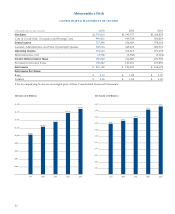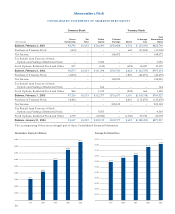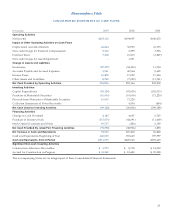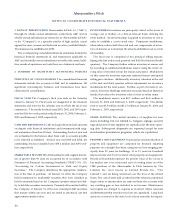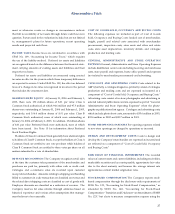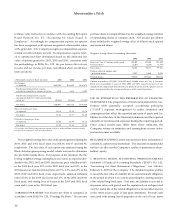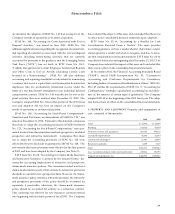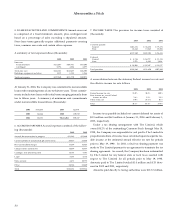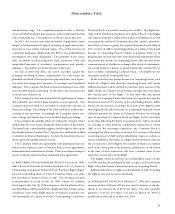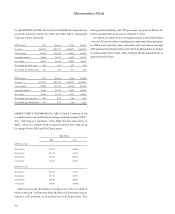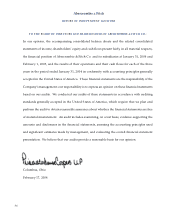Abercrombie & Fitch 2003 Annual Report Download - page 28
Download and view the complete annual report
Please find page 28 of the 2003 Abercrombie & Fitch annual report below. You can navigate through the pages in the report by either clicking on the pages listed below, or by using the keyword search tool below to find specific information within the annual report.
Abercrombie &Fitch
1. BASIS OF PRESENTATION Abercrombie & Fitch Co. (“A&F”),
through its wholly-owned subsidiaries (collectively, A&F and its
wholly-owned subsidiaries are referred to as “Abercrombie & Fitch”
or the “Company”), is a specialty retailer of high quality, casual
apparel for men, women and kids with an active, youthful lifestyle.
The business was established in 1892.
The accompanying consolidated financial statements include the
historical financial statements of, and transactions applicable to,
A&F and its wholly-owned subsidiaries and reflect the assets, liabil-
ities, results of operations and cash flows on a historical cost basis.
2. SUMMARY OF SIGNIF ICANT ACCOUNTING POLICIES
PRINCIPLES OF CONSOLIDATION The consolidated financial
statements include the accounts of A&F and its subsidiaries. All
significant intercompany balances and transactions have been
eliminated in consolidation.
FISCAL YEAR The Company’s fiscal year ends on the Saturday
closest to January 31. Fiscal years are designated in the financial
statements and notes by the calendar year in which the fiscal year
commences. The results for fiscal years 2003, 2002, and 2001 repre-
sent the fifty-two week periods ended January 31, 2004, February 1,
2003 and February 2, 2002, respectively.
CASH AND EQUIVALENTS Cash and equivalents include amounts
on deposit with financial institutions and investments with origi-
nal maturities of less than 90 days. Outstanding checks at year end
are reclassified in the balance sheet from cash to accounts payable
to be reflected as liabilities. At fiscal year end 2003 and 2002, the
outstanding checks reclassified were $33.2 million and $29.0 mil-
lion, respectively.
MARKETABLE SECURITIES All investments with original maturi-
ties of greater than 90 days are accounted for in accordance with
Statement of Financial Accounting Standards (“SFAS”) No. 115,
“Accounting for Certain Investments in Debt and Equity
Securities.” The Company determines the appropriate classifica-
tion at the time of purchase. At January 31, 2004, the Company
held investments in marketable securities that were classified as
held-to-maturity based on the Company’s positive intent and abil-
ity to hold the securities to maturity. Primarily all securities held by
the Company at January 31, 2004 were municipal debt securities
that mature within one year and are stated at amortized cost that
approximates market value.
INVENT ORIES Inventories are principally valued at the lower of
average cost or market, on a first-in-first-out basis, utilizing the
retail method. An initial markup is applied to inventory at cost in
order to establish a cost-to-retail ratio. Permanent markdowns,
when taken, reduce both the retail and cost components of inven-
tory on hand so as to maintain the already established cost-to-retail
relationship.
The fiscal year is comprised of two principal selling seasons:
Spring (the first and second quarters) and Fall (the third and fourth
quarters). The Company further reduces inventory at season end
by recording an additional markdown reserve using the retail car-
rying value of inventory from the season just passed. Markdowns
on this carryover inventory represent estimated future anticipated
selling price declines. Additionally, inventory valuation at the end
of the first and third quarters reflects adjustments for inventory
markdowns for the total season. Further, as part of inventory val-
uation, inventory shrinkage estimates are made, based on historical
trends, that reduce the inventory value for lost or stolen items.
The markdown reserve was $4.7 million and $6.8 million at
January 31, 2004 and February 1, 2003, respectively. The shrink
reserve was $3.3 million and $11.5 million at January 31, 2004 and
February 1, 2003, respectively.
STORE SUPPLIES The initial inventory of supplies for new
stores including, but not limited to, hangers, signage, security
tags and point-of-sale supplies are capitalized at the store open-
ing date. Subsequent shipments are expensed except for new
merchandise presentation programs, which are capitalized.
PROPERTY AND EQUIPMENT Depreciation and amortization of
property and equipment are computed for financial reporting
purposes on a straight-line basis, using service lives ranging prin-
cipally from 30 years for buildings, 10 to 15 years for leasehold
improvements and 3 to 10 years for other property and equipment.
Beneficial leaseholds represent the present value of the excess of
fair market rent over contractual rent of existing stores as of the
1988 purchase of the Abercrombie & Fitch business by The
Limited, Inc. (now known as Limited Brands, Inc., “The
Limited”) and are being amortized over the lives of the related
leases. The cost of assets sold or retired and the related accumulated
depreciation or amortization are removed from the accounts with
any resulting gain or loss included in net income. Maintenance
and repairs are charged to expense as incurred. Major renewals
and betterments that extend service lives are capitalized. Long-lived
assets are reviewed at the store level at least annually for impair-
26
NOTES TO CONSOLIDATED F INANCIAL STATEMENTS



